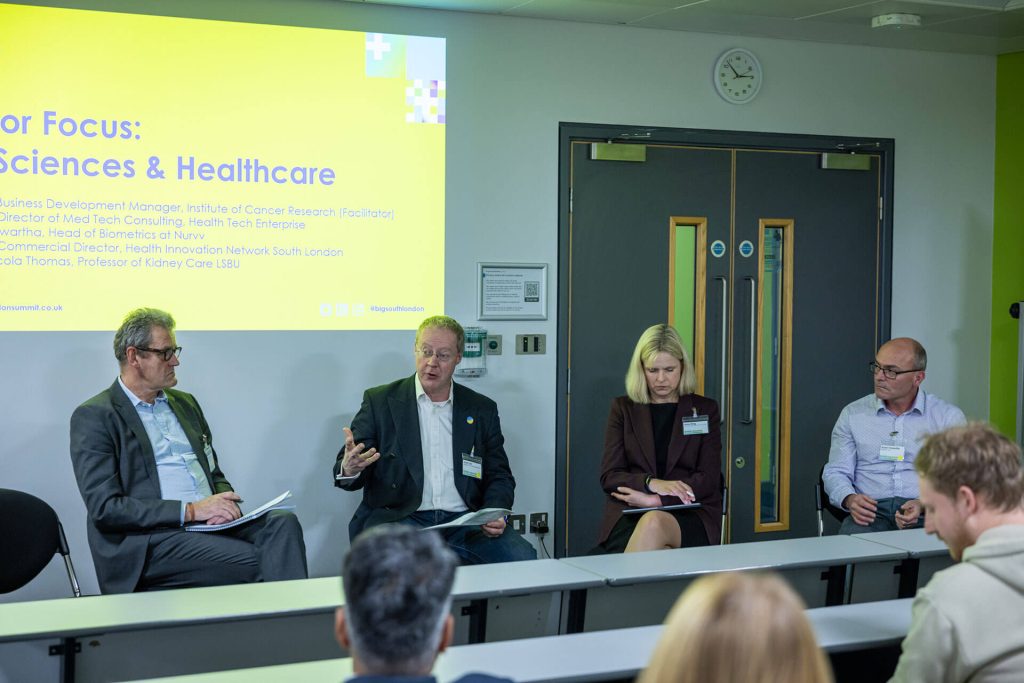Sector Focus: Life Sciences and Healthcare
Panellists: Andy Carr, Institute of Cancer Research; Joop Tanis, Health Tech Enterprise; Dr Grant Trewartha, Nurvv; Anna King, Health Innovation Network South London
Life Science and Healthcare sectors can provide opportunities for all in south London’s thriving Life Sciences and Healthcare Cluster…with the proper support!
Collaboration, specialist business support, talent and affordable spaces were all highlighted as key drivers of success for the commercialisation of innovation at the Life Sciences and Healthcare sector workshop at the recent BIG South London Business Innovation & Growth Summit.
Joop Tanis told the audience that the most effective technology is needs-driven, but success can only come if innovators collaborate with all the vested parties, including clinicians and key financial decision-makers, as well as tech innovators in the mix.
“Industry innovators all get excited about the opportunities of tech and want to develop it, but don’t always have full insight as to clinical need. Tech may be exciting, but to the users, it’s all about the impact to enable them to deliver better services. On the other hand, clinicians often have a good idea of needs and practice but won’t know which tech would help, what is the best available or already on the market, or whether there is competition.
“My best early advice for innovators is to seek advice and connect with other parts of the equation. Collaborate in order to develop the right product for clinicians’ needs, the innovators and the users.”
The speakers discussed the many challenges in the various stages of developing a new product or service and the need for funding at key stages, as well as signposting to the business support available.
Anna talked about the many ways in which the sector can be supported, including the Health Innovation Network in South London, which had been set up to spread innovation in South London across the NHS with the twin purpose of improving health outcomes and developing an innovation ecosystem of high growth businesses.
She said the network worked with universities, healthcare providers and councils to look at high-priority areas where there is scope to work with innovators, such as Sweatcoin, to improve health outcomes. She said the network provides mentoring, supports clinical entrepreneurs who want to take a business idea forward and also works with NHS professionals who want to adopt an innovation in their service, taking them through the steps needed to achieve the change.
“We support 20 innovators to scale each year and have supported 150 companies to date and are keen to work more closely with hospitals, and the innovation potential in hospitals is really powerful.”
Dr Grant Trewartha said there was a huge value to businesses like his in being part of a cluster like the one in South London.
“In terms of being in a cluster and the networking opportunities, this has been eye-opening for us. Often in the UK, you feel by yourself, so hearing about other companies in South London where there are other people doing similar things is quite supportive. I am quite excited about going forward in the cluster and finding out where the support is and the signposting for the help.
“There is no single front door with the NHS. We found it easier in the US than in the UK because here, it is not easy to know who to talk to. We need the signposting to know what the decision process is, what the journey is and if you are new to the area that is a difficult landscape to understand. So, support with schemes like this is critical to achieving success.”
Other challenges discussed included the importance of making the area an attractive place of work in order to develop a cluster of talent and the need for affordable spaces such as the Innovation Gateway, which provided easy access to central London, as well as to hospital facilities and partners but at a price which suited start-ups and spinouts.
The speakers agreed that the top trends for innovators to focus on were those which helped with successful selling into the NHS – the innovation either needs to save money right away, increase productivity or efficiency so they can do more with their budgets, or it is needed to meet regulatory requirements.
Anna said that digital is a massive drive for change in the medical and health sector as it is by far the largest area of unmet need in an NHS looking for solutions and change and also matches well with the large number of early-stage businesses looking to grow.
Anna said innovations which helped with elective care and, in particular, supporting efficient patient flow through hospitals, in particular with A&E rates and the flow to social care, were likely to be popular.
Joop said that the general trend over the past 40 years had been to find a way of moving healthcare, such as diagnostics, away from clinics and to self-management of healthcare, and this was only likely to accelerate, given the ageing society and limited budgets.
“Self-management and remote monitoring, enabling treatment away from expensive clinics and clinician time, is the way forward. We did it with books, insurance and banking. We should be able to manage our health more.”



